
Georg Baselitz is a German painter, sculptor and graphic artist. In the 1960s he became well known for his figurative, expressive paintings. In 1969 he began painting his subjects upside down in an effort to overcome the representational, content-driven character of his earlier work and stress the artifice of painting. Drawing from myriad influences, including art of Soviet era illustration art, the Mannerist period and African sculptures, he developed his own, distinct artistic language.
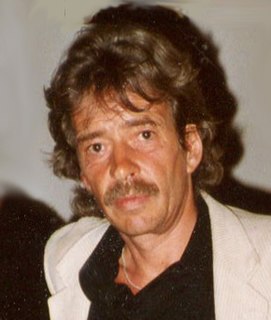
Walter Stöhrer (1937–2000) was a German painter born in Stuttgart. Between 1952 and 1954 he studied as a commercial graphical artist (Werbegraphiker), receiving a journeyman's certificate. In 1955 he began to study painting at the Academy of Arts in Karlsruhe and in 1957 became a member of the class of HAP Grieshaber, where he remained until 1959. In 1959 he left Karlsruhe for Berlin, to operate and live as free artist. In 1984 Stöhrer became a member of the Academy of the Arts in Berlin. Between 1981 and 1982 he was visiting professor at the Hochschuleder Künste, the Berlin University of the Arts. In 1986 he obtained a chair at that same institution.
Matthias Weischer is a painter living in Leipzig. Weischer is considered to be part of the New Leipzig School.

Adolf Richard Hölzel was a German painter. He began as a Realist, but later became an early promoter of various Modern styles, including Abstractionism.
Christian Möller is a German artist and painter. He studied at the Academy of fine arts in Karlsruhe by Horst Antes from 1986 to 1992.

Markus Vater is a German artist. He studied at the Kunstakademie Düsseldorf and the Royal College of Art, London. From 2012 to 2016 he had been teaching at the Royal College of Art in London. In 2014 he had a guestprofessorship at the Hochschule für bildende Künste Hamburg and from 2016 to 2019 at the Staatliche Akademie der Bildenden Künste Karlsruhe. Currently he is teaching at the Hochschule der bildende Künste Essen. His studio is at Studio Voltaire. Vater lives in London and works in London and Essen.

Willi Baumeister was a German painter, scenic designer, art professor, and typographer. His work was part of the art competitions at the 1928 Summer Olympics and the 1932 Summer Olympics.
Peter Kuckei is a German painter and stained glass artist.
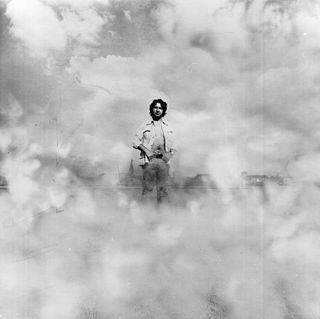
Gotthard Graubner was a German painter, born in Erlbach, in Saxony, Germany.
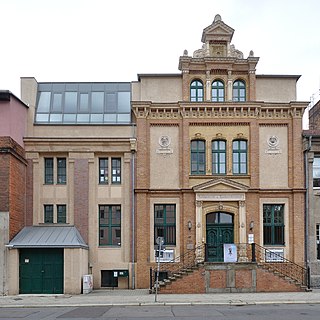
A Kunstgewerbeschule was a type of vocational arts school that existed in German-speaking countries from the mid-19th century. The term Werkkunstschule was also used for these schools. From the 1920s and after World War II, most of them either merged into universities or closed, although some continued until the 1970s.
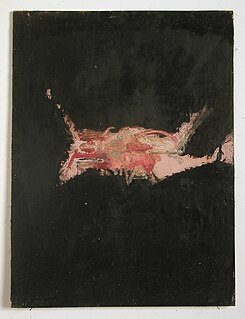
Mark Lammert, is a German painter, illustrator, graphic artist and stage designer. He lives and works in Berlin.
Georg Meistermann was a German painter and draftsman who was also famous for his stained glass windows in the whole of Europe.
Karin Sander is a German conceptual artist. She lives and works in Berlin and Zurich.
Ralph Ueltzhoeffer is a German conceptual sculptor, photographer and an internationally exhibited installation artist. He received his Bachelor of Fine Arts at Akademie der Bildenden Künste, Karlsruhe by Horst Antes. Ueltzhoeffer was born in Mannheim, Germany, lives and works currently in London and Berlin. His work has been exhibited in museums and expositions including the Shanghai Biennale "Rehearsal" (2010) and Willy Brandt Forum, Unkel.

Anthonie Wilhelmus (Toon) Verhoef is a Dutch painter, ceramist and art lecturer.

The State Academy of Fine Arts Stuttgart is a university in Stuttgart, Germany. Founded on 25 June 1761, and located since 1946 on the Weißenhof, the Academy, whose historical significance marks names such as Nicolas Guibal, Johann Heinrich von Dannecker, Bernhard Pankok, Adolf Hölzel, Willi Baumeister, Herbert Hirche, K.R.H. Sonderborg, Alfred Hrdlicka, Heinz Edelmann, Marianne Eigenheer, Richard Sapper, Joseph Kosuth, David Chipperfield, Joan Jonas, Micha Ullman, offers from all art universities in the federal state Baden-Württemberg the largest numbers of courses, namely all disciplines of the visual field, and not just in an organizational network but also under one roof. This is essentially the result of the connection of the former Academy of Fine Arts with the former School of Applied Arts in 1941 as Staatliche Akademie der bildenden Künste Stuttgart, which was reconstituted by Theodor Heuss in 1946 under the same name and which aimed at a broad training program as well as an intensified development in the following decades. Under the rectorate of Wolfgang Kermer, on 22 February 1975, the ″Gesetz über die Kunsthochschulen im Lande Baden-Württemberg (Kunsthochschulgesetz)″ passed by the Landtag of Baden-Württemberg came into force, which for the first time in the history of the State Academy of Fine Arts Stuttgart regulated the status and the essential relationships and which guaranteed the equality of rank with universities.
Wolfgang Kermer is a German art historian, artist, art educator, author, editor, curator of exhibitions and professor. From 1971 to 1984 he was repeatedly elected Rector of the State Academy of Fine Arts Stuttgart and thus the first scientific and at the same time youngest teacher in this position in the history of the university. Under his rectorate, the State Academy of Fine Arts Stuttgart was reformed in 1975 and 1978 on the base of two new university laws of the State of Baden-Württemberg and thus, for the first time in its history, authorized to set up diplomas for all courses. His focus is the history of Visual arts education, the art of Willi Baumeister and the history of the State Academy of Fine Arts Stuttgart and its predecessor institutions.
Rudi Tröger is a German painter and university professor. From 1967 to 1992 he was a professor for painting art at the Academy of Fine Arts, Munich.
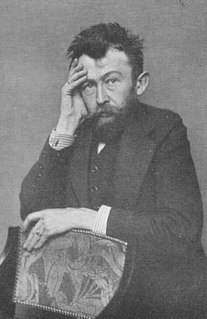
Paul Horst-Schulze was a German painter, graphic artist and artisan. His stage name Horst-Schulze came about by combining his middle name with his original family name.
Damenakademies or Ladies Academies were painting and drawing schools for women in Germany. Until the 20th century, it was difficult for women to take up an artistic profession. They were usually denied access to the academies. While in Russia, women were able to study at the academies as early as 1871, however in Germany, it was not possible until the beginning of the Weimar Republic. Apart from the private studios of individual artists, there were only three large educational institutions available to women, and these only offered a limited range of courses. The three institutions were the Ladies Academies (Damenakademies) and were founded through self-help groups in Munich and Berlin, and the Artist Academy in Karlsruhe.












